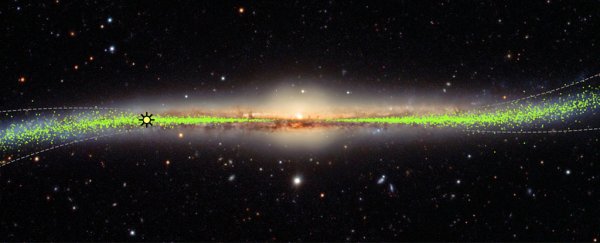Despite the classic images we can all imagine, the Milky Way isn't quite the flat disc shape we thought it was: a study published in February showed evidence of serious warping around the galaxy's edges, and now a second study has backed up the idea of a twisted Milky Way.
A team from the University of Warsaw in Poland has put together a new three-dimensional map of our galaxy, using distances between classical Cepheid variable stars as markers. These young, giant stars are 100 to 10,000 times brighter than the Sun, and that brightness allows scientists to detect them even at great distances, through interstellar dust and clouds.
Such stars also produce regular light pulses, and the team used this variability to determine the position of 2,431 Cepheids dotted through the Milky Way.
"Our map shows the Milky Way disk is not flat. It is warped and twisted," says astrophysicist Przemek Mroz.
The research is indebted to the Optical Gravitational Lensing Experiment or OGLE, a telescope and astronomical project that, so far, has more than doubled the number of known classical Cepheids in the galaxy – akin to improving the resolution on a digital image.
Data from OGLE was augmented with classical Cepheids spotted in the General Catalogue of Variable Stars (GCVS), the All Sky Automated Survey (ASAS), the All-Sky Automated Survey for Supernovae (ASAS-SN), the Asteroid Terrestrial-Impact Last Alert System (ATLAS), and the Gaia Data Release 2 (Gaia DR2) catalog.
In other words, this is quite the mapping project.
Observations of Cepheid variable stars were also used in the research released in February, but the new data adds accuracy, detail and constraints to the observations that have already been made about the warped shape of the Milky Way.
It means less guesswork and estimation is required when working out the precise shape of our galaxy; we know the Milky Way is a spiral galaxy, and it's not unusual for galaxies like ours to get a little warped around the edges. What is unusual is that the Milky Way's warping includes young stars.
One possibility is that the outer disc of the Milky Way is lagging behind, but still getting pulled by the massive inner disc, creating a kind-of elongated S shape rather than a perfectly flat disc.
As more observations are made, and more data gets collected, we'll get a better idea of the shape of the galaxy we're living in. In turn, that will help us to investigate the Universe at large – the location of dark matter, our neighbouring galaxies, and more.
It's not easy trying to map out a giant galaxy while you're living inside it, but as you can see, astronomers are really giving it a go. The Milky Way is thought to be at least 150,000 light-years across, filled with perhaps as many as 400 billion stars and at least 100 billion planets – enough to keep the stellar cartographers busy for a while.
The research has been published in Science.
